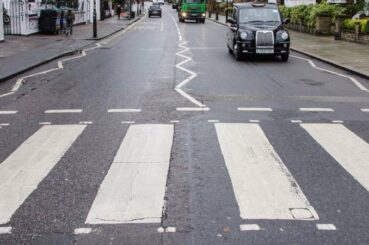
Pedestrian crossings are designed to offer a safe place for pedestrians and other road users like cyclists to cross the road. Given that the department of transport statistics show in 2017 there was 470 pedestrian’s fatalities and 23,805 pedestrian causalities, it is important you understand the importance and rules of different types of pedestrian crossings.
Many people learn about pedestrian crossings when preparing for their driving test. However, there is a lot to take in, and once you pass your test and start driving for real, it is easy to quickly forget or get confused about the different types of crossings.
To make sure you are clued up we’ve taken a look at the five main different types of pedestrian crossings used in the UK.
Different types of pedestrian crossings in the UK
Zebra Crossing
Zebra crossings are easy to recognise because of the distinctive (zebra-like) black and white stripes that form a path across a road. The path is further marked by flashing yellow Belisha beacons at either side of the road. Zebra crossings also feature white zigzag lines on the road as you approach the crossing. You should never park or attempt to overtake when in this area.
Zebra crossings are not recommended on roads where traffic speeds are higher than 35mph, so are usually only used in towns or villages where the speed limit is 30mph.
Advice for drivers at zebra crossings
– Pedestrians always have priority
– There are no traffic lights at zebra crossings so you should approach a zebra crossing with care and be on the lookout for pedestrians who are potentially about to cross the road.
-If you notice a pedestrian at the side of the road waiting to cross the road, you should slow down and prepare to stop to let them cross.
– You should stop before the dotted white line on the road.
– Failing to give way to pedestrians at a Zebra crossing is a criminal offence and can result in points on your licence

Pelican Crossing
Pelican crossings are often used in heavily populated areas, zones where the traffic speed is above 35mph or where there is a greater risk to pedestrians. This is because pelican crossings incorporate traffic lights to control traffic flow.
Pelican is short for Pedestrian Light Controlled Crossing, and that is exactly what a pelican crossing does. The pedestrian pushes a button at the crossing which triggers the traffic lights to switch from green to red to stop traffic. Once the traffic lights are on red pedestrians are signalled by a light on the opposite side of the road that it is safe to cross. This is usually accompanied by a beeping sound or a tactile rotating knob under the push buttons, which indicates to the visually impaired that it is safe to cross.
Advice for drivers at pelican crossings
When approaching a pelican crossing drivers should look to see if there are any pedestrians waiting to cross at either side of the road. If there are drivers should approach with caution and be prepared to stop if the traffic light turns to red.
It is important for drivers to remember what the traffic lights at a pelican crossing indicate:
Red Light – stop behind the solid white line. Crossing over this line could result in you getting penalty points on your licence and a fine. Many traffic lights are now equipped with cameras to monitor this.
Amber Light – Means prepare to stop. Driving through an amber light is only acceptable if you have already crossed over the white stop line.
Flashing Amber Light – Pelican crossings are the only place where you see flashing amber lights, and they indicate that the green light is coming. If there is a pedestrian on the crossing you should stay stationary until they have safely crossed, however, if there is nobody on the crossing and the light is flashing amber you may proceed.
Green Light – Go! However, it is always important to check a pedestrian hasn’t just stepped out into the crossing.

Puffin Crossing
A puffin crossing is short for Pedestrian User-Friendly Intelligent Crossing. A puffin crossing works in a similar way to a pelican crossing. However, unlike pelican crossings which work on timers, a puffin crossing is fitted with smart sensors which monitor whether the crossing is clear or nor and switches the lights accordingly. This helps keep traffic flowing more freely.
The signal to tell pedestrians it is safe to cross on a puffin crossing is located next to pedestrians on the side of approaching traffic, the idea being that this encourages pedestrians to look at approaching traffic so that they do not cross when it is unsafe to do so.
Advice for drivers at puffin crossings
– As with the previous crossings on approaching a puffin crossing, you should be prepared to stop if a pedestrian presses the button on the crossing.
– There is no flashing amber light at a puffin crossing, meaning it is only safe to proceed when the traffic light turns green.
– If a pedestrian crosses a puffin crossing at a funny angle they may not trigger the sensors, so you should always proceed with caution and stay alert for pedestrians nipping across the road.

Toucan Crossing
A toucan crossing is similar to a puffin crossing, however, it has been specifically designed for pedestrians and cyclists to be able to cross together – two can cross – hence toucan.
For this reason, they are slightly wider than most puffin crossings. There is also usually a cyclist on the signal as well as a pedestrian.
Cyclists should not use zebra, pelican or puffin crossings, therefore, toucan crossings are usually found in areas where cyclists are prevalent, such as close to parks or areas which have lots of cycle lanes.
Advice for drivers at toucan crossings
– The same rules apply for toucan crossings as apply for puffin crossings.
– However, there is no amber flashing light on toucan crossings, so once the sensors detect the crossing is clear the traffic lights will change to green to indicate you can proceed.
– Remember you need to keep your eye out for both pedestrians and cyclists.

Pegasus Crossing
A pegasus crossing is also known as an equestrian crossing. It is specifically designed for pedestrians and horse riders to be able to cross the road safely together. It is the least common type of crossing in the UK, and they are only usually located near race-courses or horse training areas.
A pegasus crossing features an additional button raised 2m above the standard button, so horse riders don’t need to dismount to use the crossing. But otherwise, it works in much the same way as a toucan crossing with sensors detecting when the crossing is clear and signalling for the light to change to green. Like a toucan crossing, there is no flashing amber light at a pegasus crossing.
Advice for drivers at pegasus crossings
– A pegasus crossing should be approached in the same way as a toucan or puffin crossing.
– However, you should take extra care when approaching and leaving the crossing to keep engine revs low and movements smooth to avoid startling any horses.
– It is also a good idea to leave plenty of room between your car and the crossing so that horse riders can cross safely.





